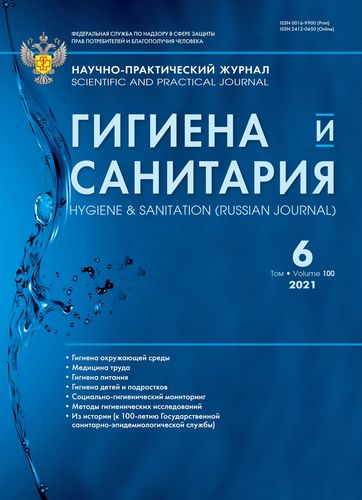Gas chromatography/tandem mass spectrometry with long-term alkaline transesterification for the determination of esters of monochloropropanediols and glycidol with fatty acids in edible vegetable oils and fats
- Authors: Makarenko M.A.1, Malinkin A.D.1, Bessonov V.V.1
-
Affiliations:
- Federal Research Centre of Nutrition and Biotechnology
- Issue: Vol 100, No 6 (2021)
- Pages: 640-646
- Section: METHODS OF HYGIENIC AND EXPERIMENTAL INVESTIGATIONS
- Published: 14.07.2021
- URL: https://rjraap.com/0016-9900/article/view/639311
- DOI: https://doi.org/10.47470/0016-9900-2021-100-6-640-646
- ID: 639311
Cite item
Full Text
Abstract
Introduction. The article discusses the method of determination of 2-, 3-monochloropropanediol (2-MCPDE, 3-MCPDE) and glycidyl (GE) fatty acids esters in edible vegetable oils and fats by slow alkaline transesterification and GC-MS/MS. Many toxicological data showed these substances to have the potential for human health risks if consumed; in addition, existing determination methods have various limitations. So, there is a need to expand the variety of 2-MCPDE, 3-MCPDE and GE determination methods.
Materials and methods. 2- and 3-MCPD esters, and glycidyl esters in their corresponding free forms were measured by slow alkaline transesterification with GC-MS/MS.
Results. Multiple reactions monitoring mode parameters were optimized. Compared to SIM operating mode, MRM mode improved the selectivity and increased the signal-to-noise ratio. The method was linear in the range of 0.3 mg/kg - 30.0 mg/kg for each analyte. Recovery, tested in this range, was found to be 87.5%-113.6 %.
Conclusion. The method discussed here was based on the ISO 18363-2: 2018 standard. In contrast to the last one, we used tandem chromatography-mass spectrometry to detect analytes and a method of absolute calibration with internal standards to quantitate them. In addition, it is proposed to analyze a spiked sample during the sequence of unknown samples to improve the quality of results.
About the authors
Mariia A. Makarenko
Federal Research Centre of Nutrition and Biotechnology
Author for correspondence.
Email: dragon.soul1992@ya.ru
ORCID iD: 0000-0003-1688-6304
MD, junior researcher in the laboratory of food chemistry, Federal Research Center of Nutrition and Biotechnology, Moscow,
109240, Russian Federation.
e-mail: dragon.soul1992@ya.ru
Russian FederationAlexey D. Malinkin
Federal Research Centre of Nutrition and Biotechnology
Email: noemail@neicon.ru
ORCID iD: 0000-0002-0370-4500
Russian Federation
Vladimir V. Bessonov
Federal Research Centre of Nutrition and Biotechnology
Email: noemail@neicon.ru
ORCID iD: 0000-0002-3587-5347
Russian Federation
References
- Risks for human health related to the presence of 3- and 2-monochloropropanediol (MCPD), and their fatty acid esters, and glycidyl fatty acid esters in food. EFSA J. 2016; 14(5): 4426. https://doi.org/10.2903/j.efsa.2016.4426
- Gao B., Li Y., Huang G., Yu L. Fatty Acid Esters of 3-Monochloropropanediol: A Review. Annu. Rev. Food Sci. Technol. 2019; 10(1): 259–84. https://doi.org/10.1146/annurev-food-032818-121245
- Tiong S.H., Saparin N., Teh H.F., Ng T.L.M., Zain M.Z.B., Neoh B.K., et al. Natural organochlorines as precursors of 3-monochloropropanediol esters in vegetable oils. J. Agric. Food Chem. 2018; 66(4): 999–1007. https://doi.org/10.1021/acs.jafc.7b04995
- Hrncirik K., van Duijn G. An initial study on the formation of 3‐MCPD esters during oil refining. Eur. J. Lipid Sci. Technol. 2011; 113: 374–9. https://doi.org/10.1002/ejlt.201000317
- Weißhaar R., Perz R. Fatty acid esters of glycidol in refined fats and oils. Eur. J. Lipid Sci. Technol. 2010; 112: 158–65. https://doi.org/10.1002/ejlt.200900137
- Jędrkiewicz R., Kupska M., Głowacz A., Gromadzka J., Namieśnik J. 3-MCPD: A worldwide problem of food chemistry. Crit. Rev. Food. Sci. Nutr. 2016; 56(14): 2268–77. https://doi.org/10.1080/10408398.2013.829414
- EFSA Panel on Contaminants in the Food Chain (CONTAM), Knutsen H.K., Alexander J., Barregård L., Bignami M., Brüschweiler B., Ceccatelli S., et al. Update of the risk assessment on 3-monochloropropane diol and its fatty acid esters. EFSA J. 2018; 16(1): 5083. https://doi.org/10.2903/j.efsa.2018.5083
- Schultrich K., Frenzel F., Oberemm A., Buhrke T., Braeuning A., Lampen A. Comparative proteomic analysis of 2-MCPD- and 3-MCPD-induced heart toxicity in the rat. Arch. Toxicol. 2017; 91(9): 3145–55. https://doi.org/10.1007/s00204-016-1927-0
- Appel K.E., Abraham K., Berger-Preiss E., Hansen T., Apel E., Schuchardt S., et al. Relative oral bioavailability of glycidol from glycidyl fatty acid esters in rats. Arch. Toxicol. 2013; 87(9): 1649–59. https://doi.org/10.1007/s00204-013-1061-1
- Makarenko M.A., Malinkin A.D., Bokov D.O., Bessonov V.V. Monochloropropanediols, glycidol and their esters in children food. Voprosy detskoy dietologii. 2019; 17(1): 38–48. https://doi.org/10.20953/1727-5784-2019-1-38-48 (in Russian)
- Zelinkova Z., Giri A., Wenzl T. Assessment of critical steps of a GC/MS based indirect analytical method for the determination of fatty acid esters of monochloropropanediols (MCPDEs) and of glycidol (GEs). Food Control. 2017; 77: 65–75. https://doi.org/10.1016/j.foodcont.2017.01.024
- Crews C., Chiodini A., Granvogl M., Hamlet C., Hrnčiřík K., Kuhlmann J., et al. Analytical approaches for MCPD esters and glycidyl esters in food and biological samples: A review and future perspectives. Food Addit. Contam., Part A. 2012; 30(1): 11–45. https://doi.org/10.1080/19440049.2012.720385
- Kuhlmann J. Determination of bound 2,3‐epoxy‐1‐propanol (glycidol) and bound monochloropropanediol (MCPD) in refined oils. Eur. J. Lipid Sci. Technol. 2011; 113: 335–44. https://doi.org/10.1002/ejlt.201000313
- Weißhaar R. Determination of total 3‐chloropropane‐1,2‐diol (3‐MCPD) in edible oils by cleavage of MCPD esters with sodium methoxide. Eur. J. Lipid Sci. Technol. 2008; 110: 183–6. https://doi.org/10.1002/ejlt.200700197
- Goh K.M., Wong Y.H., Ang M.Y., Yeo S.C.M., Abas F., Lai O.M., et al. Comparison assessment between SIM and MRM mode in the analysis of 3-MCPD ester, 2-MCPD ester and glycidyl ester. Food Res. Int. 2019; 121: 553–60. https://doi.org/10.1016/j.foodres.2018.12.013
Supplementary files









